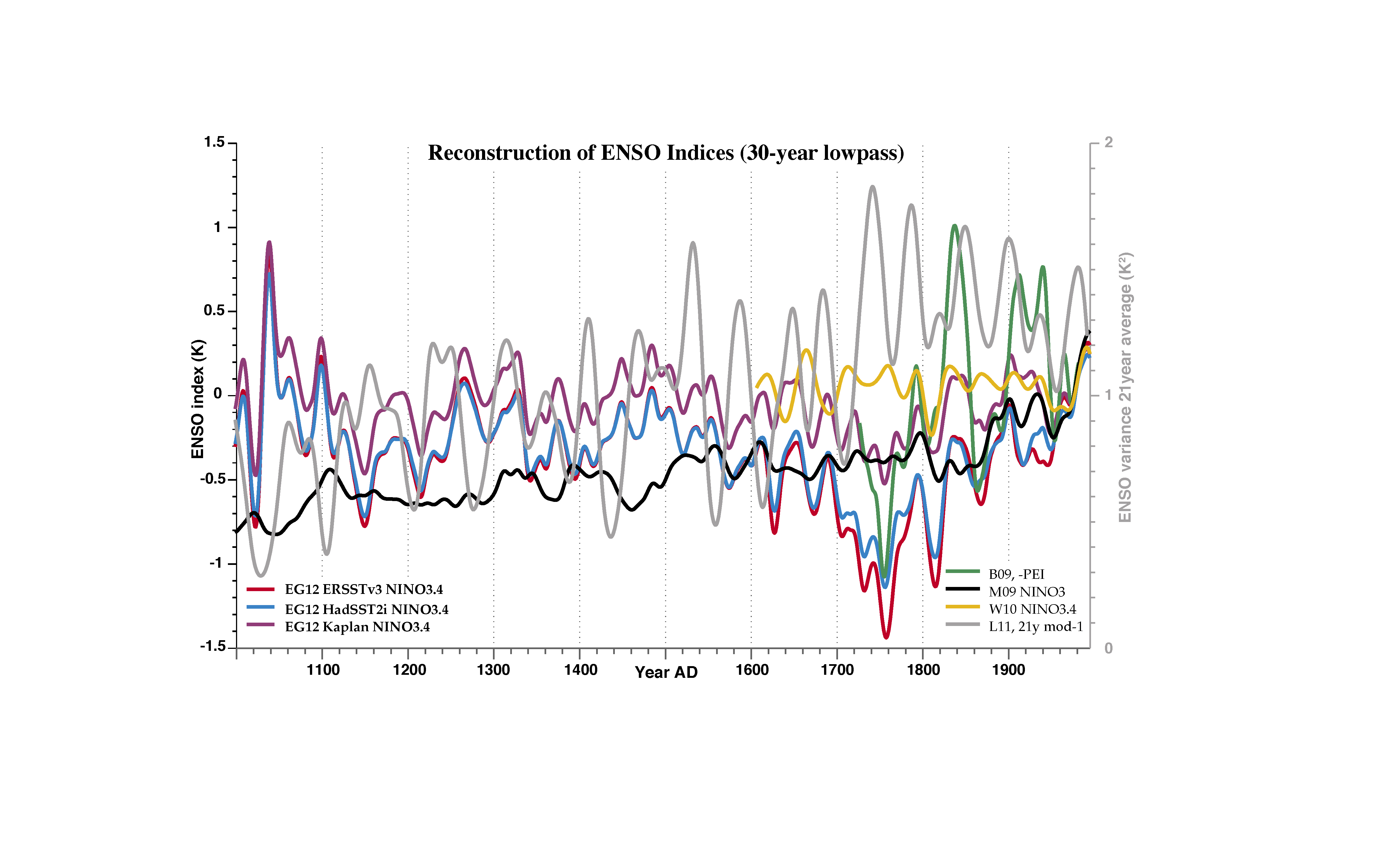- Home
- Publications
- PAGES Magazine
- El Niño-Southern Oscillation - What Is The Outlook For ENSO? [Past]
El Niño-Southern Oscillation - What is the outlook for ENSO? [Past]
Julien Emile-Geay
PAGES news
20(1)
29
2012
Julien Emile-Geay
Department of Earth Sciences & Center for Applied Mathematical Sciences, University of Southern California, Los Angeles, USA; julieneg usc.edu
usc.edu
Despite considerable progress in understanding the El Niño-Southern Oscillation (ENSO) over recent decades, several mysteries remain:
- How irregular is ENSO?
- What causes its decadal modulation?
- How does radiative forcing (in particular anthropogenic forcing) influence this system?
The paleoclimate record can shed light onto some of these questions. As recounted by A. Clement (this issue) there is now strong evidence that ENSO has been active since the Pliocene warm epoch and through glacial cycles, suggesting that the phenomenon is rather impervious to external influences. The details are far thornier, for even a small change in the character of ENSO or its teleconnections can have far-reaching societal impacts (e.g. Hsiang et al. 2011). Since very few high-resolution archives take ENSO’s pulse from the heart of the tropical Pacific, one must rely on archives from remote sites, which are vulnerable to interferences from local effects or changing teleconnections.
High-resolution sedimentary and coral records have suggested a rise in ENSO activity since the mid-Holocene (Moy et al. 2002; Tudhope et al. 2001). Emerging evidence from longer coral records from this period suggests that this situation is more nuanced (Cobb, McGregor and Tudhope, pers. comm.). This is consistent with a numerical experiment (Wittenberg 2009), which underscores that long observational windows are needed to characterize ENSO's non-stationary behavior.
The wealth of detailed paleoclimate archives spanning the past millennium provides a unique opportunity to test this idea. Li et al. (2011) [L11] took advantage of interannual signals embedded in drought-sensitive tree rings from North America to suggest a link to various indicators of its low-frequency behavior. A recent multiproxy study (Mann et al. 2009 [M09]) argued that the Little Ice Age (~1500-1800 AD) saw enhanced ENSO variability and a warmer eastern equatorial Pacific compared to the “Medieval Climate Anomaly” (~900-1300 AD), consistent with previous studies (Cobb et al. 2003; Mann et al. 2005; Graham et al. 2010). Yet a multiproxy reconstruction based on the latest observations (Emile-Geay et al. 2012 [EG12]) suggests a more granular picture, with no clear dichotomy between the two periods (Fig. 1). This reconstruction and those of Wilson et al. (2010) [W10] and Braganza et al. (2009) [B09] contain considerable decadal and centennial variability - an important benchmark for climate models to reproduce. Nonetheless, the divergence between these estimates exposes considerable uncertainties, due in part to proxy errors and to the short calibration period that the instrumental record condemns us to. Adding to this uncertainty is the divergence between instrumental products over the tropical Pacific (e.g. Deser et al. 2010), which propagates beyond instrumental times [EG12].
ENSO’s response to external forcing over the last millennium is thus poorly constrained. Despite original suggestions of an El Niño-like response to explosive volcanism (Adams et al. 2003), the latest data from Palmyra Island do not appear to support this notion (Cobb 2011). Difficulties in reconstructing low-frequency variability further beset a tie to solar forcing. To establish a clear link between natural radiative forcing and the low-frequency modulation of ENSO, one would need more long and accurately dated tropical Pacific records than are presently available.
Were such a link eventually to be elucidated by new proxy observations, there is no guarantee that ENSO will react similarly to greenhouse forcing as it did to a changing Sun: greenhouse forcing has a very different vertical structure from solar forcing; it is differently impacted by clouds and aerosols, and acts 24 hours a day, unlike the Sun. These differences limit the extent to which natural forcings can serve as analogs for anthropogenic ones. Therefore, one should not view ENSO’s past as a set of prophecies, but, rather, as a rich laboratory in which to test the models used to predict its future. The PAGES-sponsored PMIP3 data/model intercomparison effort is expected to bring much insight into this problem.
selected references
Full reference list online under: http://pastglobalchanges.org/products/newsletters/ref2012_1.pdf
Braganza K et al. (2009) Journal of Geophysical Research 114, doi: 10.1029/2008JD010896
Li J et al. (2011) Nature Climate Change 1(2): 114-118
Mann ME et al. (2009) Science 326(5957): 1256-1260
Wilson R et al. (2010) Journal of Quaternary Science 25(1): 62-78
